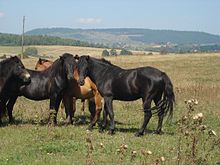Bosnian Mountain Horse
 | |
| Conservation status | |
|---|---|
| Other names | |
| Country of origin | Bosnia and Herzegovina |
| Traits | |
| Weight |
|
| Height |
|
The Bosnian Mountain Horse (Bosnian: Bosanski brdski konj / Босански брдски коњ)[2] is the only indigenous breed of domestic horse in Bosnia and Herzegovina, where it constitutes about 70% of the horse population. It is a small horse and is used both as a pack animal and for riding. Breed numbers were severely reduced during the Bosnian War of 1992–1995, and, unlike populations of other farm animals, continued to fall after the end of the war.[6]
History
[edit]
Selective breeding of the Bosnian Mountain Horse began at the stud of Goražde in 1908. The principal centres for the selection of the breed were the stud farms of Borike, in the municipality of Rogatica, and Han Pijesak. Three stallion lines – Agan, Barut and Miško – and nine mare lines were established; the Agan line is lost, and the Barut and Miško lines heavily mixed. Arab stallions at the Borike stud were used to improve the Bosnian Mountain Horse.[6]
There are two types within the breed. The Glasinacki type has substantial Arab influence; it is named after the plateau of Glasinac on the Romanija mountain, in the eastern part of the Republika Srpska.[3][7]: 35 A smaller type, the Podveleški, is found in Herzegovina.[4]
Horse populations – like those of other farm animals – suffered heavily during the Bosnian War of 1992–1995. In the Federation of Bosnia and Herzegovina, the total number of horses fell from 46628 in 1990 to 16080 in 1995, and by 2002 had fallen further to 7014, or about 15% of the pre-war number; in the Republika Srpska numbers also fell, though not so steeply. Overall, horse numbers in Bosnia and Herzegovina fell by 68% between 1990 and 2002.[6]
The breed has not been substantially affected by importations of foreign horses. It is in some areas the principal, or even the only, means of transportation.[6]
Characteristics
[edit]A survey of 3800 of the horses in the 1950s found the commonest colour to be bay, accounting for 38% of the total, followed by grey (28%), black (18%), chestnut (13%), dun and striped dun (3%) and isabelline (0.13%).[8]: 168
References
[edit]- ^ Barbara Rischkowsky, Dafydd Pilling (editors) (2007). List of breeds documented in the Global Databank for Animal Genetic Resources, annex to The State of the World's Animal Genetic Resources for Food and Agriculture. Rome: Commission on Genetic Resources for Food and Agriculture, Food and Agriculture Organization of the United Nations. ISBN 978-92-5-105762-9. Archived 23 June 2020.
- ^ a b c d Breed data sheet: Bosnian Mountain / Bosnia and Herzegovina (Horse). Domestic Animal Diversity Information System of the Food and Agriculture Organization of the United Nations. Accessed June 2023.
- ^ a b Breed data sheet: Glasinacki / Bosnia and Herzegovina (Horse). Domestic Animal Diversity Information System of the Food and Agriculture Organization of the United Nations. Accessed June 2023.
- ^ a b Breed data sheet: Podveleski / Bosnia and Herzegovina (Horse). Domestic Animal Diversity Information System of the Food and Agriculture Organization of the United Nations. Accessed June 2023.
- ^ Valerie Porter, Lawrence Alderson, Stephen J.G. Hall, D. Phillip Sponenberg (2016). Mason's World Encyclopedia of Livestock Breeds and Breeding (sixth edition). Wallingford: CABI. ISBN 978-1-78064-794-4.
- ^ a b c d [State Veterinary Administration of Bosnia and Herzegovina] (s.d.). Animal genetic resources in Bosnia and Herzegovina, annex to The State of the World's Animal Genetic Resources for Food and Agriculture. Rome: Commission on Genetic Resources for Food and Agriculture, Food and Agriculture Organization of the United Nations. ISBN 978-92-5-105762-9. Archived 23 June 2020.
- ^ Waltraud Kugler (2009). Rare Breeds and Varieties of the Balkans: Atlas 2009. St. Gallen, Switzerland: Monitoring Institute for Rare Breeds and Seeds in Europe. Archived 27 November 2018.
- ^ Fahrudin Hrasnica (1957). Die Auswertung der Erbtypen in der Züchtung des bosnischen Gebirgspferdes (in German). Zeitschrift für Tierzüchtung und Züchtungsbiologie. 70 (2): 163–174. doi:10.1111/j.1439-0388.1957.tb01042.x.
Further reading
[edit]- Enver Žiga, Refik Telalbašič (2008). Bosanski brdski konj: monografija = The Bosnian Mountain Horse - monograph. Sarajevo: TKD Šahinpašic. ISBN 978-9958-41-256-1.
- Gertrud Grilz-Seger, Thomas Druml (2015). Das Bosnische Gebirgspferd. Graz: Vehling Verlag GmbH. ISBN 978-3-85333-263-4.
- Refik Telalbašić, Enver Žiga, Alma Rahmanović (2011). Matična knjiga Bosanskog brdskog konja. Sarajevo: TKD Šahinpašić. ISBN 978-9958-41-447-3.
- Enver Žiga, (2023). Kako smo spašavali Bosanskog brdskog konja. Sarajevo: Connectum. ISBN 978-9958-29-219-4.
